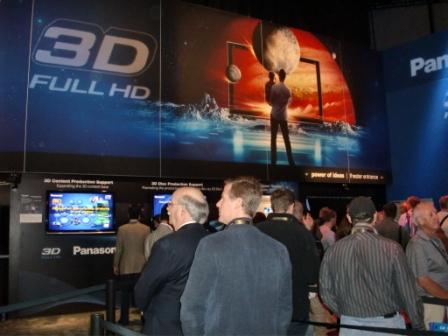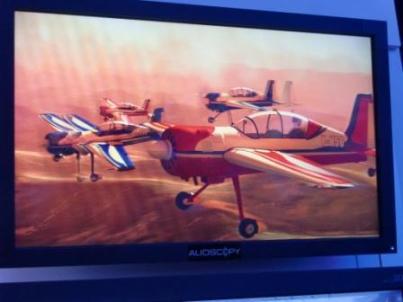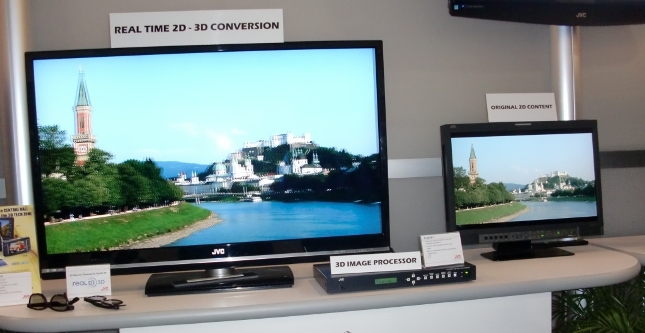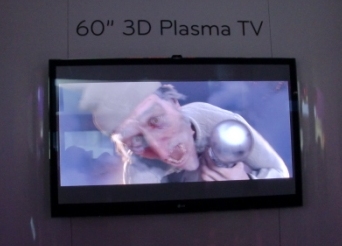It might be a zoo, but I've always considered the Consumer Electronics Show in Las Vegas the most wonderful time of the year. It's Disneyland for adults.
Parts of this CES column appeared in earlier Huffington Post reports. "The Writers Workbench" is a monthly column on the website for the Writers Guild of America. To see this entire report, with complete product graphics," please click here
This year, the economy took its toll, and CES was notably smaller. But make no mistake, it was still crowded, and still a technological madhouse.
And being massive, the tale of it must be, too. So, find yourself a comfortable chair and a bowl of popcorn. This will be long. But chock full o' stuff. (That's the technical term.)
Every year at CES, a theme tends to present itself, and this year that was more obvious that usual.
Home 3-D television was easily the biggest attention-grabber at the show. But before we get into how it all looked - and yes, yes, I can hear you all anxiously salivating already - it's important to put it all in perspective first, because the hype (not only at CES, but in the press throughout the country) was so pervasive it made people think that 3-D is not only here, but sitting by your elbow already.
Okay, then, first things first. 3-D TV is clearly coming. The question is whether it will settle into the form most vendors are pushing at the moment. The technology is basically here, and the technology is very good. But the questions are as follows.
People will need to buy a TV that can handle 3-D. It will likely be expensive at first, though that will come down. But a people have just been pushed into buying Digital TVs and then HD TVs. Will they be willing now, today, to ditch those and by a new TV? Or will that purchase still be several years away?
For movies, the only technology that can play 3-D is Blu-Ray, and the reality is not all that many people have upgraded yet to Blu-Ray players. Will most people continue to be perfectly happy with normal DVDs?
Here's a big, question and one rarely addressed. Unlike going to a special event movie, will people be willing to wear 3-D glass for their four hours of TV a night -- every night? Not only is that cumbersome, but it's not how people watch TV. They multitask -- watch TV, read magazines, talk to people in the room, go to the kitchen, and so on. This may be the biggest hurdle 3-D TV has to overcome.
Also, what will the standard be for glasses? Right now there are several. The red-blue glasses. Polarizing glasses. And electronic shutter glasses. (This latter is considered the best, but most expensive. It sends blisteringly fast pulses alternating into each eye. But even here, there is no standard. Sony has one, but NVIDIA has another - though NVIDIA (a chip maker) only produces 3-D for computers, not TV.
In talking with an NVIDIA manager, he said compatibility of technologies isn't an issue. "You'd only be watching your Panasonic TV with Panasonic glasses." However, I offered a devil's advocate scenario -- what if your friend was having a football game party and showing it on his Sony set, but you only had Panasonic glasses? "Good point," he said. And there's another related issue that will have to be resolved, among all the hype: people invite friends to their homes all the time and then watch TV. How do you handle that? You're not likely going to have a half dozen spare glasses sitting around.
One way around this is the 3-D technology that doesn't require glasses. I've been seeing demonstrations for years, and it's fascinating. But it's not ready yet for home consumption. For one thing, right now, you need to be in a specific spot. It'll have to be developed so that everyone in the room can see the 3-D. (Will this be possible?) That said, I did see a demonstration by Intel of 3-D without glasses, and it was an improvement over what existed just a year ago. A group of people standing around in a wider range could see a passable effect. It's still not remotely there yet for general use, but moving in the right direction.
(Yes, I know you can't actually see this non-glasses 3-D effect, but there it is anyway...)
So, fine, all that aside, how does 3-D TV look? LG Electronics, Toshiba, Panasonic, JVC...fill in the blank of your favorite; 3-D TVs overflowed everywhere. Happily, the technology appears terrific, and is near ready. The clarity was strong, and the separation was pronounced. It might not quite be as rich or at the level of what you're used to in a movie theater, but being so intimate, that seemed to enhance the effect.
(3-D for computers has been around for a few years. A demonstration using the NVIDIA chip and glasses, and Cyberlink playback software, was wonderful. It doesn't require getting a new computer, just a upgraded video card. Plus the glasses, of course, and a Blu-Ray drive if you want to play movies.)
There was another aspect of 3-D TV that was important. JVC and Toshiba both demonstrated "realtime" imaging technology that converts current 2-D content to 3-D. They actually do a respectable job creating a 3-D effect...but it's not seamless. It sort of looks like cut-outs put on top of other images, which is what creates the perception of depth. (I will admit to not feeling a compelling need to see Pat Sajack and Vanna White in 3-D, though it did make the studio set look layered.)
(Okay, again, you won't see the 3D effect, I know, I know -- but at least you can note the crisp standard image on the right for comparison.)
At the moment, the cost for this won't come cheap. One of JVC's Real 3-D monitors that looked to be about 36-40" will retail for $9,000. (It uses polarizing glasses.) LG Electronics was displaying a 72" LCD TV and a 60" gas plasma model, though no prices were available. They say that the TVs should be available the second half of the year.
(You know the drill by now. Hey, it's the best I can do without coming into your home lugging a gas plasma 3-D display.)
Toshiba brought in a separate wrinkle - further enhancements on the Motion Gesture Technology that CES first saw last year. This uses hand movements to control a TV rather than a remote control. Toshiba's version adds a 3-D graphic that looks like the Death Star that you can "spin" to pick video choices. There's a fascinating sci-fi gimmick sense to it, and it's worked out some earlier issues (like focusing its sensor on one area, so one's children won't take over). But other questions remain, like what if you move around? Or, what if a guest is alone and doesn't know the gestures? And - isn't it easier to have a remote control that says "Pause," rather than remember the hand gesture?
Remarkably, there was a world of TV at CES that wasn't 3-D. Honest. And one area is something the multinational media companies insisted during the Writers Strike they needed three years to simply study, because it was too new-fangled - and that's the convergence between TV and the Internet.
It can't be said more clearly: anything written here won't give the full impact on how mature and pervasive this technology is. It was mature and pervasive two years ago, when companies insisted it didn't exist. Today, it's so in-depth that it's second nature.
TV sets using services such as the Sharp Vudu are, in essence, seamless Internet TVs, with no barrier between the two. A screen of applications is displayed, from folders like News, Arts & Entertainment and Sports, to such Web standards as Flicker, Facebook and Wikipedia. Or even the New York Times. All on the TV.
Microsoft's Mediaroom 2.0 goes even deeper. It's an entertainment platform across "all networks and devices" - that means from TV, PC and mobile. The licensing service allows all multimedia to be integrated and then viewed not only in one's home, but in the "cloud," giving you access your content anywhere in the world, whether on your home TV, computer or mobile device.
(Note to studios: Microsoft is considered quite a large company. Shockingly, it has apparently already figured out multimedia integration of TV and the Internet. But then, this is version 2. You see, they introduced the service two years ago.)
Further, Roku and the Boxee Box (and no, that isn't a new animated series from Japan) while providing slightly different services from each other, connect with your TV via Wi-Fi and basically let you watch Netflix movies, Major League Baseball, Amazon Video-on-Demand and much more -- up to 100 such channels by the end of the year - or any of the content on your computer. Somewhat similarly, PlayOn software installs on one's computer and, when wirelessly connected to a "DLNA-compatible device" (like an Xbox 360, Playstation 3 or Wii), you can get any media content from the Internet on your TV - Hulu, CNN, ESPN360, Netflix, the NFL Network and more. It's close to possible to drop your cable contract and watch most TV - and Internet - for virtually free. The Seagate Free Agent Theater and Western Digital TV Live do essentially similar things, as well, albeit in their own ways.
But it's not just home TV that is now integrated with the Internet. Cydle's Mobile TV i30 puts TV on your iPhone, iPod touch or any Smart Phone, using a Wi-Fi connection.
Or consider mSpot Mobile Movies, which streams rented movies directly to your mobile device. Nothing is even downloaded. It simply works via Wi-Fi or G3 connection. All of mSpot's content is through deals with each movie studio. Indeed, when I mentioned to the company's rep that this reality of converging technology was one of the core issues in the Writers Guild Strike, when the companies insisted there wasn't any money in the Internet yet, he broke into laughter. "No money?," he said, "Then maybe they'll give us back everything we pay them! Because we pay them a lot."
Moving on, you'll note that when discussing television I haven't even mentioned... televisions. That's because TVs this year joined the rarefied air of three industries so remarkably mature and massive that even the worst is now pretty darn impressive. While TV manufacturers try to differentiate themselves with meaningless buzzwords like QuadPixel and 4K x 2K Super Resolution - the truth is they all have great bells and whistles and all look wonderful.
Still, a few innovations do occasionally leap out.
Audiovox's FLO TV won a CES Innovations Award for its in-car entertainment system that delivers live TV. Once only available for certain mobile devices, the service offers up to 13 channels of remixed broadcast and cable TV programming. (Please drive carefully...)
The Kula from Sungale is a dedicated wireless device that will access 500 IPTV channels (basically TV channels that stream over the Internet). There aren't many U.S. channels available (though some), but a great many internationally are, including the BBC. The service uses a Wi-Fi connection. The first year's subscription is free, and then you pay depending on the level of service. However, 100 basic channels are available for free. It will retail for $199.
The other two aforementioned-industries that are so mature it's like a tsunami of quality washing over you to the point of meaningless are digital cameras and mobile phones. The lowest-end are still wonderful. But still, within that ocean, a few things stood out.
A camera from Nikon. the Coolpix S1000PJ, not only takes photographs, but it has a built-in projector. That means you can display what you took without needing any other device. It retails for $429.

If you already have a camera, however, and want to show your photos, Butterfly Technology offers a personal projector, about the size of a thick paperback novel. It sends out a respectable image of your photos onto a screen (or the wall). It wasn't the most crisp picture, but very presentable, and depending on the model, the images seemed up to 50" diagonal.
There also were several devices that simplified the process of transferring your photos from your camera. (Admittedly, this is not the most challenging process in the world, though these found ways to make what's easy brain-dead simple).
Eye-Fi (which got a "Best of Show" Innovations award) is nothing more at first glance that a little SD flash card that you put in your digital camera, onto which your digital photos are recorded. However, it has Wi-Fi built in, and will transfer your photos directly to your computer...without your having to do anything! As soon as it recognizes your home wireless network, it transfers them. When you walk into the room where your network is, all you have to do is turn on the camera. That's it. The Eye-Fi will automatically send your pictures to a folder on your computer.
Somewhat related to this is PanDigital's Photo Mail. The digital frame comes with its own unique email address, and you can therefore email photos directly to the frame. No cards to transfer, no cords to attach. The free email service is provided in conjunction with AT&T, and the microchip within the frame is embedded with virus protection.
As for cell phones, they are so full-featured today that I believe they now will do your homework, cook dinner and can serve as an emergency life raft.
That said, it's worth noting the Saygus VPhone. It's the first mobile phone in the U.S. market that allows low-bandwith, 2-way video calls. A "Best of Innovations" winner, 3G is not required. At the moment, this videoconferencing only works in the United States, though the company is working on certification worldwide.
Of course, the world of iPhones is another matter entirely, since - along with iPods in general - it's the growing mountain of peripherals and apps that set them apart, rather than merely the devices themselves. It's not uncommon to see pretty much anything that doesn't market itself as being iPhone/iPod compatible. I await the day when a banana with iPod docking port shows up.
The L5 Remote, for instance, allows an iPhone or iPod touch to become a universal remote control. Download a free app and attach in a small dongle. That's all. Just set it up for your devices, as the same as you would with any remote. (While quite remarkable, it does require that you keep the small dongle either plugged in all the time or accessible, which some might find inconvenient.)
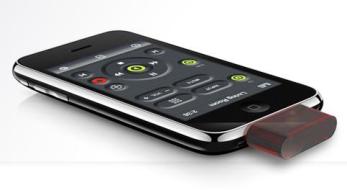
The Viper Smart Start, another CES Innovations winner, lets you lock/unlock and start your car from your iPhone. (This has more of an application in the Midwest and Northeast, where getting your car warm before getting in can be a God-send.)
For those who use other MP3 players, you're not forgotten. Getjar is a website that has the second-most apps outside of the iStore - the difference is that it's for non-iPhone/iPod devices. Once it determines what device you do have, it will make all the apps available.
And if you've ever wanted to migrate all your iTunes library to other devices, but were lost at the process, Dazzboard reads your iTunes library and transfers the contents onto any Android, Symbian, Windows Mobile or regular MP3 device. Basically, they call themselves iTunes for non-iTunes devices.
Speaking of playing music, a little company, new to the U.S. market, XMI, introduced the newest addition to its remarkable line of tiny, but powerful and rich portable speakers. (It core product, the X-Mini II, is about the size of a golfball, and has seriously impressive sound.) The new X-Mini Max II is slightly larger, though will still fit in your pocket, and separates into impressive stereo speakers.
Tiny is always the byword at CES. And Verbatim has entered the fray...er, little-time. Its Tuff-n-Tiny USB flash drive is about the size of a thumbnail. Yet it holds 8 gigabytes. (With a 16 gig model to come.) The company insists that the "tuff" part of the name is well-earned for being waterproof, dustproof and you can drive a car over it.
Another small, and feature-filled USB flash drive is the Lexar Echo ZE Backup Drive. About the size of half a thumb, this is designed for "permanent" use in a notebook or netbook. ("Plug and Stay," the company calls it.) What stands out is that it offers a backup solution for people who never backup their portable computer. It has software that recognizes major data file formats and automatically backs up all those files on your system, somewhat like the high-capacity Clickfree external hard drives. It then continues to back up files as you save them. The ZE currently is available in 8 and 16 gigabytes, with 32 coming.
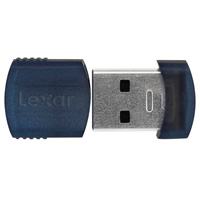
The aforementioned Clickfree recently introduced the C2 portable external hard drive with an improved interface, back-up scheduler, and built-in USB cord. About the size of a small remote control, it can hold up to 500 gigabytes. As mentioned, it recognizes thousands of standard file formats and starts backing up the moment you plug it in. You do nothing.) For notebooks/netbooks - or any portable storage -- the company offers the Clickfree Traveler. The size of a credit card, it fits in your wallet and models hold from 8 to 16 gig...with 32 coming. The built-in USB cable plugs into your portable computer and then starts backing up instantly.
Of course, at CES even something as basic as a regular external hard drive can end up being noteworthy. Seagate's Black Armor, for example (there are others), is based on USB 3.0, the new standard for USB connections. What this means is that transfers of data - like, when you're copying photos to an external drive) will be up to a blistering 10 times faster than now. Computers with USB 3.0 ports won't be available until later in the year, but even now with just a USB 2.0 port you'll get about three times faster speed plugging in a USB 3.0 device.
Pogoplug uses external hard drives in a fascinating way. Introduced last year, it's finally hitting this market. This is a device that simply connects to an external drive and your network router. From that point on, you can access any content on that external drive from anywhere in the world - documents, photos, music, whatever. (You log into your personal account on the company's website.) A nice improvement is that the Pogoplug now includes an automatic backup option. It retails for $129.
This is actually a growing concept. Seagate has introduced a similar product (licensed from Pogoplug, in fact), and Verbatim has its My Media Server.
For those who care about portability and accessing their data from anywhere, Verbatim is bringing out an especially small portable drive, the world's smallest, they say, the Titan XS. It fits in your shirt pocket. Capacity will start at 320 gigabytes and go up to 640 gig. Prices start at $100.
Small, as noted earlier, is always an important concept at CES. And Toshiba has a new, full notebook computer that's surprisingly not much bigger than a netbook, and at a cost not all that much more ($549-699, depending on the configuration). The T135-D is ultrathin, has a respectable keyboard, a 13.3" screen, and all the features of a full notebook (except a DVD drive).
Netbooks are not known for their toughness, but Samsung has added durability to its new NB30 netbook. It's not a tank, to be sure. But there is a sensor built in that will stop the hard disk from spinning if the computer falls, protecting it up to a 30-inch drop. Also, the keyboard is sealed to make it spill resistant (within reason), and the outer cover is rubberized to be scratch resistant. Its battery also rated for 11 hours, though your mileage will vary. My one quibble is personal, that it has flat "Chiclet" style keys, but other people may like those.
eBooks is another technology that got a major push at CES. Whether that market is large enough to sustain all the competition, we'll see. At the moment, the biggest alternative to the Kindle is Barnes & Noble's new eBook reader, Nook. (One little tweak they offer: if you go into one of their stores with your eBook reader, it will recognize you and send special promotions, like free cookies. Okay, I said it was a little tweak. But I'm sure they'll develop it further...)
On the home office front, Zip DZ is a fascinating service for conference call meetings. They provide a real-time transcriber and audio files, so you can click on any part of the call and hear the audio again. You can either have a human transcriber (the Scribe service) which is the most accurate, costs $100/hour, and runs about two minutes behind the conversation), or an automated computer-based transcription (Scribble, which only has a 30-second lag and is just $10/hour, though not as accurate). There's also a charge per person per minute, but fairly inexpensive.
And for those who want to expand their writing to novels, Fast Pencil is an interesting self-publishing company. Depending on factors like the sophistication you want for your produced book and cover, and the number of books printed, costs vary. But prices were reasonable, and the percentage of sales for the author is quite high.
Finally, what would CES be without the bizarre? And hands down, the winner was Smoking Everywhere, an electronic cigarette. Yes, you read that correctly. It looks pretty much like a cigarette, but has no tobacco, no ash, no tar or smoke. There's a nicotine cartridge, micro chip, lithium battery and atomizer. (Just like Sir Walter Raleigh envisioned.) The tip glows when puffed, and a vapor even billows out like a cloud of smoke when exhaling. I didn't try it, but the few who actually did had smiles on their faces, appreciating the fact that they could smoke in smokeless environments.
But then, all of CES is pretty bizarre. And much of that lunacy will be making its way into your home and life. And some of it, eventually, will be in 3-D.
To see this column with complete product graphics, visit the WGA website.

